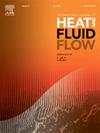Analytical modeling of simultaneous phase transitions in a low-temperature evaporator for a pilot-scale Organic Rankine Cycle using R134a: A comparative study with water coolant
IF 2.6
3区 工程技术
Q2 ENGINEERING, MECHANICAL
International Journal of Heat and Fluid Flow
Pub Date : 2024-12-06
DOI:10.1016/j.ijheatfluidflow.2024.109685
引用次数: 0
Abstract
This study focuses on comparing the heat and water recovery performance of two coolants, R134a refrigerant and water, in a low-temperature evaporator (LT-E) designed for a pilot-scale Organic Rankine Cycle (ORC). The primary objectives were to develop a one-dimensional analytical model capable of predicting simultaneous phase transitions—internal flow boiling of R134a and condensation of water vapor from flue gas on the outer tube wall—and to compare the heat and mass transfer performance of R134a with that of water. Baseline modeling conditions included a flue gas temperature of 57.3 °C, coolant inlet temperature of 16 °C, and a coolant mass velocity of 126.4 kg/sm2, with inlet pressures of 630 kPa for R134a and 100 kPa for water. The model’s predictions showed average discrepancies of 10 % for water recovery efficiency and 3 % for flue gas exit temperature when compared to experimental data. Case studies revealed that R134a outperformed water in heat flux by 16 % to 67 %, and water recovery efficiency was 15 % to 68 % higher with R134a. Increased heat exchanger surface area improved recovery efficiency for both coolants, eventually reaching an asymptotic limit.
求助全文
约1分钟内获得全文
求助全文
来源期刊

International Journal of Heat and Fluid Flow
工程技术-工程:机械
CiteScore
5.00
自引率
7.70%
发文量
131
审稿时长
33 days
期刊介绍:
The International Journal of Heat and Fluid Flow welcomes high-quality original contributions on experimental, computational, and physical aspects of convective heat transfer and fluid dynamics relevant to engineering or the environment, including multiphase and microscale flows.
Papers reporting the application of these disciplines to design and development, with emphasis on new technological fields, are also welcomed. Some of these new fields include microscale electronic and mechanical systems; medical and biological systems; and thermal and flow control in both the internal and external environment.
 求助内容:
求助内容: 应助结果提醒方式:
应助结果提醒方式:


